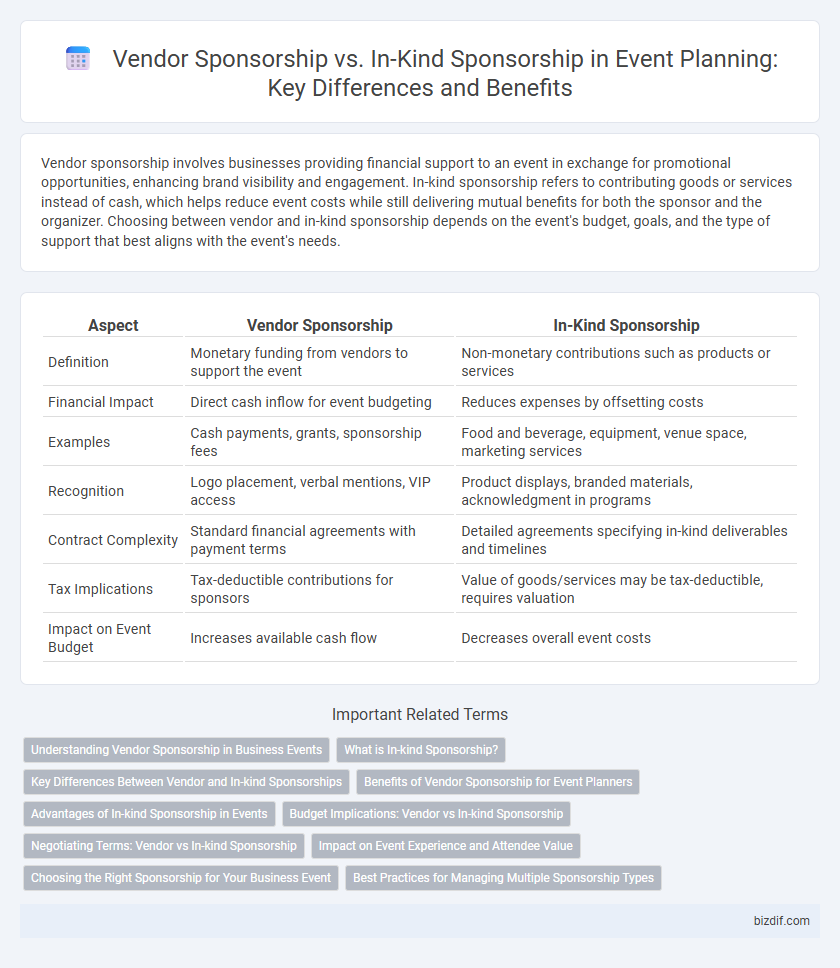Vendor sponsorship involves businesses providing financial support to an event in exchange for promotional opportunities, enhancing brand visibility and engagement. In-kind sponsorship refers to contributing goods or services instead of cash, which helps reduce event costs while still delivering mutual benefits for both the sponsor and the organizer. Choosing between vendor and in-kind sponsorship depends on the event's budget, goals, and the type of support that best aligns with the event's needs.
Table of Comparison
| Aspect | Vendor Sponsorship | In-Kind Sponsorship |
|---|---|---|
| Definition | Monetary funding from vendors to support the event | Non-monetary contributions such as products or services |
| Financial Impact | Direct cash inflow for event budgeting | Reduces expenses by offsetting costs |
| Examples | Cash payments, grants, sponsorship fees | Food and beverage, equipment, venue space, marketing services |
| Recognition | Logo placement, verbal mentions, VIP access | Product displays, branded materials, acknowledgment in programs |
| Contract Complexity | Standard financial agreements with payment terms | Detailed agreements specifying in-kind deliverables and timelines |
| Tax Implications | Tax-deductible contributions for sponsors | Value of goods/services may be tax-deductible, requires valuation |
| Impact on Event Budget | Increases available cash flow | Decreases overall event costs |
Understanding Vendor Sponsorship in Business Events
Vendor sponsorship in business events involves companies providing financial support or products in exchange for brand visibility and promotional opportunities, enhancing event quality and reach. Unlike in-kind sponsorships, which contribute goods or services directly, vendor sponsorship often includes contractual agreements that outline specific marketing benefits such as logo placement, speaking opportunities, or exclusive rights. Understanding vendor sponsorship allows event planners to strategically secure funding while aligning sponsor objectives with event goals to maximize mutual value.
What is In-kind Sponsorship?
In-kind sponsorship refers to the provision of goods or services by a vendor instead of monetary support for an event. This type of sponsorship often includes items like catering, equipment rental, or promotional materials that directly contribute to event success. Leveraging in-kind sponsorship helps reduce costs while enhancing vendor visibility through product placement or service showcasing.
Key Differences Between Vendor and In-kind Sponsorships
Vendor sponsorship involves a company providing financial support or products in exchange for promotional opportunities during an event, which directly boosts the event's budget and marketing reach. In-kind sponsorship refers to contributions of goods or services instead of cash, helping reduce event expenses without immediate financial transactions. The key difference lies in vendor sponsorship's emphasis on monetary exchange and branding exposure, whereas in-kind focuses on resource sharing and operational support.
Benefits of Vendor Sponsorship for Event Planners
Vendor sponsorship offers event planners direct financial support and access to high-quality products or services, enhancing event execution without upfront costs. This form of sponsorship builds long-term partnerships, ensuring reliable resources and potential discounts for future events. Leveraging vendor sponsorship also elevates event credibility by associating with reputable brands, attracting a larger audience and increasing overall event value.
Advantages of In-kind Sponsorship in Events
In-kind sponsorship offers event planners the advantage of reducing cash expenses by receiving goods or services directly from vendors, such as catering, equipment, or promotional materials. This type of sponsorship enhances vendor engagement and creates authentic brand integration, boosting event credibility and attendee experience. Leveraging in-kind contributions also simplifies budget management and fosters long-term partnerships between event organizers and sponsors.
Budget Implications: Vendor vs In-kind Sponsorship
Vendor sponsorship often includes direct financial support or services exchanged for promotional opportunities, providing clear budget relief and predictable cost coverage for event planners. In-kind sponsorship involves receiving goods or services instead of money, which can reduce expenses but requires careful valuation and may lead to unpredictable budget impacts due to variable service quality or availability. Understanding the balance between these sponsorship types helps optimize event budgets by aligning financial needs with resources offered.
Negotiating Terms: Vendor vs In-kind Sponsorship
Negotiating terms for vendor sponsorship often involves financial agreements where sponsors provide funds in exchange for marketing exposure, requiring clear payment schedules and deliverables. In-kind sponsorship negotiations focus on barter arrangements, where products or services are exchanged for promotional considerations, emphasizing the valuation and fulfillment of goods over cash transactions. Both require detailed contracts to outline expectations, timelines, and recognition to ensure mutual benefit and avoid conflicts.
Impact on Event Experience and Attendee Value
Vendor sponsorship provides financial support that can enhance event features such as entertainment, technology, and amenities, directly improving the overall attendee experience. In-kind sponsorship offers tangible goods or services, which can elevate the event's quality through cost-effective resource contributions, adding practical value for attendees. Both sponsorship types shape attendee perception, with vendor sponsorship often enabling broader event scale and in-kind sponsorship fostering personalized engagement through unique offerings.
Choosing the Right Sponsorship for Your Business Event
Evaluating vendor sponsorship and in-kind sponsorship is crucial for maximizing value in your business event. Vendor sponsorship typically involves monetary support coupled with product or service promotion, delivering measurable ROI and brand visibility. In-kind sponsorship, offering goods or services instead of cash, can reduce event costs but requires careful alignment with event goals to ensure mutual benefit and audience engagement.
Best Practices for Managing Multiple Sponsorship Types
Effective event planning requires clearly defining roles and expectations for both vendor sponsorship and in-kind sponsorship to maximize value and ensure seamless coordination. Establishing detailed sponsorship agreements specifying deliverables, timelines, and recognition methods helps avoid conflicts and fosters positive relationships with sponsors. Utilizing a centralized communication platform streamlines interactions and tracking, improving transparency and accountability across multiple sponsorship types.
Vendor sponsorship vs In-kind sponsorship Infographic

 bizdif.com
bizdif.com